



When you have successfully completed this section, you will have mastered:
Whether caused by rust and corrosion or other problems, most wiring harness problems fall into one of three categories. This chapter will help you to identify and troubleshoot each one of them.
Before Starting The Diagnosis
When it's necessary to disconnect the harness or other connections during troubleshooting, use this opportunity to thoroughly clean the terminal components and apply a good quality dielectric coating before reconnecting.
If a lamp is removed for testing and will be reinstalled, clean the terminals to remove any oxidation, corrosion or other residue. Then add a dielectric coating to both the lamp and socket and replace the lamp. When in place, test the lamp one final time for proper operation.
Always check the 7-way power cable. Verify that the circuits are all functioning at their design capacity. If there is no power, check the integrity of the power from the tractor. This step must not be skipped because from this point on, proper power to the trailer must be available.
Any reference in this section to "repairs" refers to temporary, emergency repairs only. Given the typical operating environment, the components that are repaired should be replaced as soon as possible. That will maintain the integrity and reliability of the wiring harness and minimize failures and additional repairs in the future.
Also, remember that the term "ground" refers to both the chassis ground and a ground return wire. The chassis ground is typically a frame rail or other conductor. In all cases, each possible ground must be tested.
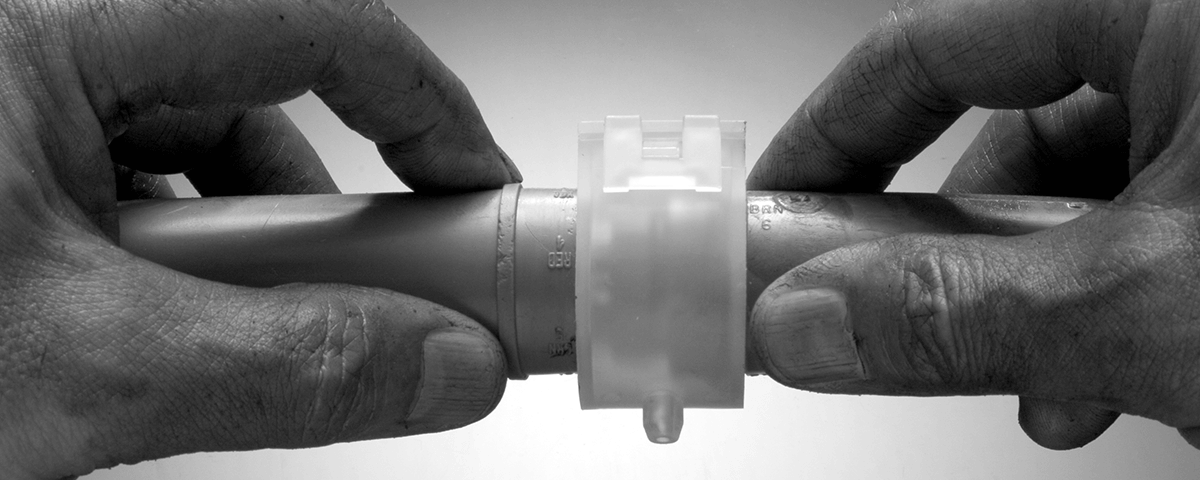
Always check the 7-way power cable.
The Three Basic Wiring Harness Problems
The wiring harness is subject to three basic problems, any of which can cause lamp failure. They are:
Open Circuits
An open circuit refers to an interruption in the circuit, such as a break in the wire. However, it could refer to an un-plugged connector or a terminal that has come loose from a chassis ground connection.
With an open circuit, current is prevented from flowing to all areas of the circuit. This means only the portion of the circuit between the break and the grounding point is affected. Lamps connected before the break will still function. The break can be in either the power or the ground segment of the circuit.
Suspect an open circuit if the circuit breaker is good and some of the lamps on that circuit are not operating.
Short Circuit
A short circuit occurs when conductors from two different circuits make contact.
Suspect a short circuit when lamps are operating intermediately with those on another circuit … for instance, clearance marker lamps are operating with stop lamps when the brakes are applied.
The most common cause of a short circuit is that two conductors are allowed to rub against each other until the insulation wears away. Wires that are not secured are among the most likely candidates, especially where there is significant vibration present.
Grounded Circuit
A grounded circuit takes place when the power circuit conductor comes in contact with a ground source, typically the vehicle chassis (like the frame rails of a trailer). If an unsecured wire or bundle is allowed to contact a sharp edge on the metal frame member, the insulation is cut or damaged due to the vibration. With the insulation gone and the bare conductor exposed, the frame can act as a ground source.
Suspect a grounded circuit if the circuit breaker cycles and there is no load on the circuit.

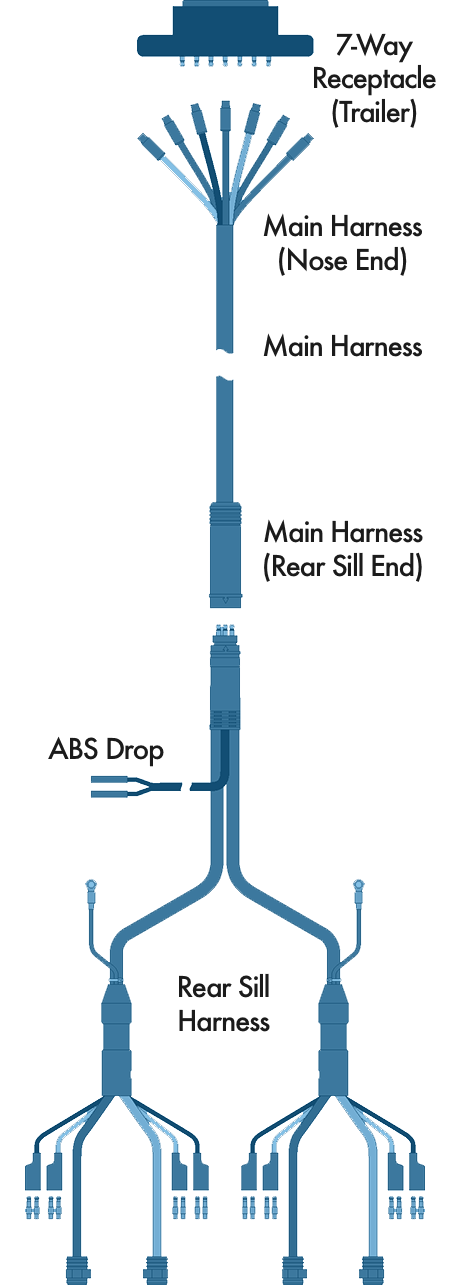
Wiring Harness Schematic
Troubleshooting An Open Circuit
It's reported that more than 90% of the open circuit conditions reported can be traced back to failed lamps. When troubleshooting, always test the lamp or lamps in question carefully. Remove the lamp; clean the contacts and retest. If the lamp still fails, replace it. If it works, apply a good quality dielectric coating, like Grote's corrosive preventative sealant 99170, to the contacts and continue testing for other causes.
Continue testing from the front of the trailer. When the need arises to disconnect components, always follow the procedures outlined above to clean and protect the connections with dielectric coating to protect against future failures.
OPEN CIRCUIT TEST 1
Disconnect the main harness from the 7-way receptacle and use a continuity tester to check the circuit in the receptacle.
If the tester doesn't light up, the indication is that it is an open circuit. In this case, the 7-way receptacle appears to be the problem. Replace it with an equivalent unit.
If the tester lamp lights up, there is power to this point and further testing is required.

OPEN CIRCUIT TEST 2
Reconnect main harness to the 7-way receptacle and dis-connect the rear still harness from the main harness. Use a tester and check the circuit between the main harness and the ground.
If the tester does not light, you have found the open circuit. The problem is in the main harness. Repair or replace the main harness. If the tester lights up and stays on, you have power to this point. Further testing is required.

OPEN CIRCUIT TEST 3
Reconnect the rear harness to the main harness and disconnect the jumper (and/or pigtail) wire in question. Using a tester, check between the circuit in question on the rear still harness and the ground.
If the tester does not light, you have found the open circuit. The problem is in the rear sill harness. Replace or repair the rear sill harness. If the lamp lights up and stays on, you have power to this point. Further testing is required.
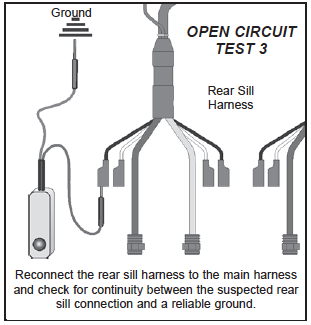
OPEN CIRCUIT TEST 4
Reconnect the jumper wire to the rear sill harness and dis-connect the lamp. Using a tester, check between the circuit in question on the jumper wire and the ground. If the tester does not light, you have found the open circuit. Replace the jumper wire.
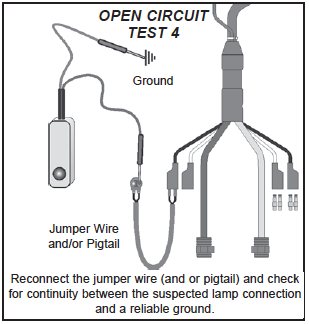
Note: All Grote Rear Sills have redundant grounds hooked through the main and ring terminals. Disconnect the ring terminal (chassis ground) when testing.
Trouble Shooting A Short Circuit
When the lamps are lighted in a circuit that should be off, it's likely that there is a short circuit. Of the three failures discussed here, this is the most difficult problem to find. Fortunately, it is the least common of all problems.
Do all of the testing on the malfunctioning circuit. First, visually inspect for the problem. If it's not obvious, then start the following tests from the rear of the trailer. When disconnection is required, follow the proper procedures for cleaning and using dielectric coating before reconnecting.
SHORT CIRCUIT TEST 1
Do not remove the lamps in question. Turn off all power with the exception of the malfunctioning circuit. Disconnect the jumper wire from the rear sill harness. Using the tester, check between the rear sill harness and ground.
If the tester does not light up, the problem is in the jumper wire. Locate and repair the short. Look for two bare wires or terminals crossed. This may require replacing the jumper wire. Reconnect the circuit. If the tester lights up, the shorted circuit is not in the jumper wire and further testing is required.
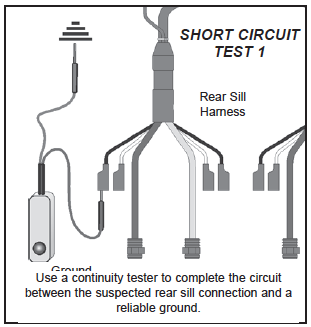
SHORT CIRCUIT TEST 2
Disconnect the rear sill harness from the main harness. Using the tester, check between the main harness and the ground.
If the tester does not light up, the problem is in the rear sill harness. Locate the short, looking for two bare wires or terminals that are crossed and repair if possible. If that cannot be found you must replace the rear sill harness. Reconnect the circuit. If the tester lights up, the shorted circuit is not in the rear sill harness and further testing is required.
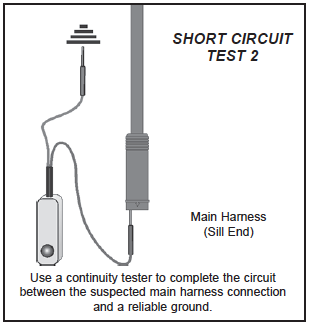
SHORT CIRCUIT TEST 3
Disconnect the main harness from the 7-way receptacle. Using the tester, check between the 7-way receptacle and the ground.
If the tester does not light up, the problem is in the main harness. Locate and repair the short. Look for two wires or terminals crossed. (This may require replacing the main harness.) Reconnect the circuit.
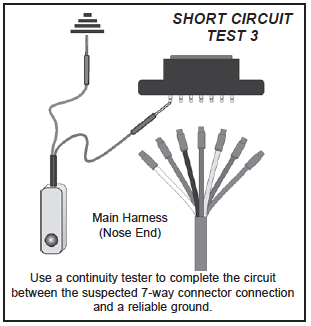
Troubleshooting A Grounded Circuit
The symptoms of a grounded circuit will be intermittent circuit breaker operation or blown fuses. All the lamps in the circuit will be off. Do all testing on the circuit that is malfunctioning.
Start testing from the front of the trailer. When disconnection is required, follow the proper procedures for cleaning and using dielectric coating before reconnecting.
GROUNDED CIRCUIT TEST 1
Disconnect all connections. Disconnect the lamps from the malfunctioning circuit. Disconnect the main harness from the 7-way receptacle. Disconnect the rear sill harness from the main harness. Disconnect all appropriate jumper wires and/or pigtails from the rear sill harness.
Turn on the switch for the malfunctioning circuit. Using the tester, check the circuit between connection in question on the 7-way receptacle and the corresponding connection in the main harness.
If the tester lights up, the problem is in the main har-ness. Replace or repair the main harness. If the tester does not light up, the grounded circuit is not in the main har-ness and further testing is required.
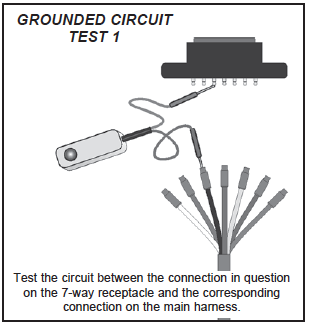
GROUNDED CIRCUIT TEST 2
Reconnect the main harness to the 7-way receptacle. Make sure that the rear sill is not grounded. Using the tester, check the circuit between the connection in question on the main harness and the corresponding connection on the rear sill harness.
If the tester lights up the problem is in the rear harness.
Replace or repair the rear still harness. If the tester does not light up, the grounded circuit is not in the rear sill harness and further testing is required.
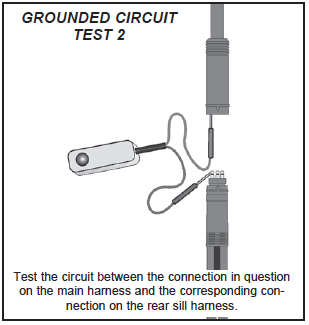
GROUNDED CIRCUIT TEST 3
Reconnect the rear still harness to the main harness. Using the tester, check the circuit between the connection in question on the rear sill harness and the jumper wire and/ or pigtail.
If the tester lights up, the problem is in the jumper wire.
Replace or repair the jumper wire. After the test, make sure all connections are secure and the harness is restored to working order. Recheck all lamps in the malfunctioning circuit. Check to see that all lamps are functional and restore them to the system.
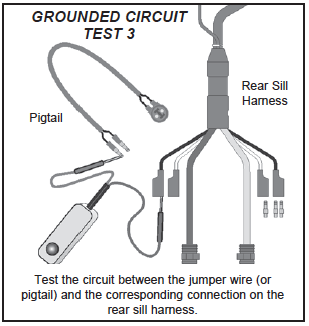
Use the self assessment below to gauge your understanding of this section. Place your answer in the box and then check your answer by clicking on the "show answer" link.
Or, you can skip the assessment.
Instructions:
Read the question.
Place your answer in the box.
Example:
True or False:
You should read the questions and then type your answer into the box.
show answer
True!
Begin:
1. True or False: After testing a lamp that proves to have additional life, always clean the terminals, apply a light coat of premium motor oil and reinstall.
show answer
False
2. Before starting to trouble-shoot a trailer system, you should always:
show answer
c) Verify that there is power to the trailer
3. True or False: An open circuit exists when there is no ground connection because of a broken wire.
show answer
True
4. True or False: A chassis ground refers to a ground connection made through the wiring harness.
show answer
False
5. True or False: Suspect an open circuit if the circuit breaker is good and some of the lamps on that circuit are not operating.
show answer
True
6. True or False: Suspect a grounded circuit when lamps are operating coincidently with those on another circuit.
show answer
False
7. True or False: A grounded circuit is a likely cause when the circuit breaker cycles and there is no load on the circuit.
show answer
True
8. Failed lamps account for ___ of all open circuits.
show answer
d) 90%
9. True or False: Wires not adequately secured are a prime cause of short circuits.
show answer
True
10. When lamps are lighted in a circuit that should be off, it’s likely that there is a:
show answer
c) Short circuit
11. True or False: The symptoms of a grounded circuit are intermittent circuit breaker operation or blown fuse.
show answer
True